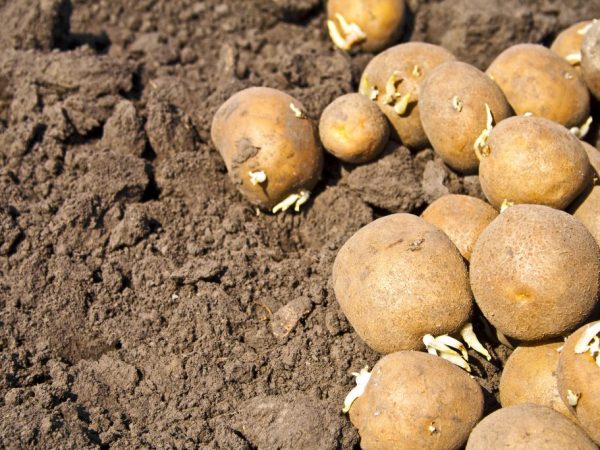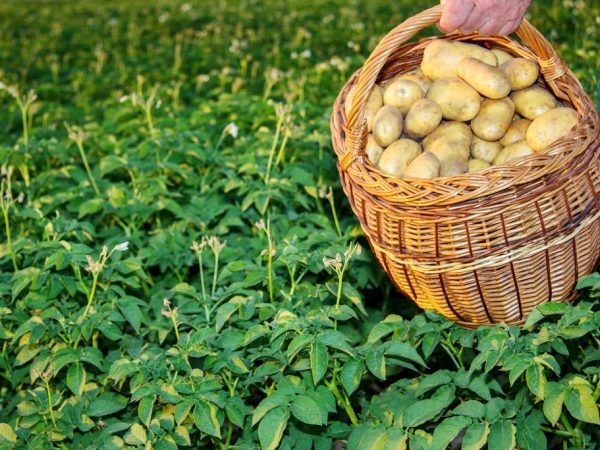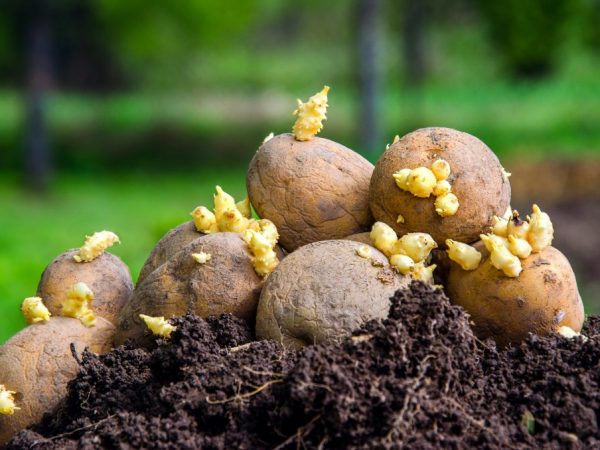Dates of planting potatoes in the Moscow region
Vegetables have long been an integral part of the human diet. Many farmers do not understand the peculiarities of cultivating root crops in their climatic zone, therefore they often face problems at all stages of cultivation. How is the correct planting of potatoes in the Moscow region going? Let's analyze the most important points, without which it is difficult to get a bountiful harvest.

Planting potatoes
Site selection
Potatoes are a light-loving culture that is sensitive to the presence of the sun. When choosing a place of growth, preference is given to well-lit areas, not fenced with fences and trees. Loamy and sandy loam soil is suitable for cultivation, which will allow you to grow root crops without problems. Dense clayey soils are made loose with sand.
The first agricultural work does not begin in the spring, but in the fall. If taken care of at the end of the previous season, then during the winter the site will be restored and will be suitable for planting potatoes. After harvesting, the earth is dug up, plant residues are removed and fertilized with a mixture of:
- humus;
- compost;
- wood ash.
In the spring, the soil is loosened with a shovel or pitchfork, without turning over the lumps. Root crops need abundant nutrition, so the site is fed with mineral or organic means. Experienced farmers advise digging at least two to three weeks before planting.
Seed material
The Moscow region belongs to the area of problem farming, which is not always characterized by warm, dry summers. For the climate of the Middle Lane, an abundance of cold rainy days in the most important stages of root crop development is customary. To secure the harvest, you should be careful about choosing a variety for planting.
- Anniversary of Zhukov. A fertile recumbent plant, the tubers of which have a strong immunity to cancer and late blight. It develops well at low temperatures.
- Son. Despite the long ripening (over 2.5 months), the culture is not demanding in terms of care and development conditions. The main advantage of the variety is the absence of degeneration during long-term cultivation in one area.
- Cast iron. The time-tested variety is ideally adapted to the climate of the Moscow region. Strong resistance to "potato" diseases and insects (bear, Colorado potato beetle).
Tubers selected for planting are planted under the diffused light of the sun. A special poisonous substance is formed inside the root crops, which creates a natural protection during storage. Thirty days before planting in the ground, the potatoes are sorted out and germinated. Immediately before agricultural work, they are treated with dressing agents.
How to plant
To get a bountiful harvest, you need to properly bury the tubers in the ground. Each gardener has his own time-tested method, but it is not always suitable for the Moscow region. There are many technologies now that can correct soil imperfections.

Fertilizing the soil
Combs
The Dutch technique involves planting potatoes on special hills from the ground. The soil is processed with a tractor, after which embankments are formed, the height of which is about fifteen centimeters. Ridge planting is relevant for areas with clay soils and closely spaced groundwater. Root crops receive enough heat and oxygen, which protects against rotting and prevents stagnation of the liquid.
The technology facilitates manual labor, therefore it is popular with domestic farmers. The potatoes are placed on the hills, after which the ridges are poured on top. According to the Dutch method, the roots are arranged according to the scheme (in cm):
- distance between tubers - 30;
- the gap between the beds is 75;
- the height of the final ridge is 35.
The disadvantage of this technology is the rapid drying of the soil, which in hot periods can lead to overheating of the plants. In this case, we advise you to increase the frequency of watering or, in the hottest hours, stretch a light fabric over the planting. If the soil is crumbling heavily, then the rows can be secured with boards.
Trenches
Many gardeners prefer to plant potatoes in the Moscow region in small ditches. The technology allows you to save moisture, which is necessary for the normal development of plants. The land is cultivated in the same way as with the ridge method, however, the roots are deepened in the ditches according to the scheme (in cm):
- the gap between the potatoes - 30;
- distance between rows - 70;
- depth - 11.
By the way, the technology is dangerous in areas with close-lying groundwater. In wet, cool summers, plantings easily attack fungi and root rot. When choosing planting in trenches, you will have to carefully prepare the seed and devote more time to care (mulching, loosening).
Smooth fit
The classic method "under a shovel" has not lost its relevance for many years, however, due to the laboriousness of the agrarians, they prefer not to get involved. Two people are involved in the work: one digs the holes, and the second puts the tubers in the holes. Seed material is placed in the ground according to the scheme (in cm):
- the distance between the potatoes is 35;
- the gap between the rows - 65;
- depth - 12.
To keep the plantation even, gardeners make plot markings with a rope. The technology will be relevant for loose, moisture-consuming soil. By the way, so that the plants do not interfere with each other, they are planted in a checkerboard pattern.
Box landing
Time-consuming preparatory work will pay off with minimal plant care during the growing season. It is enough to spend time on creating boxes once, after which they will last more than one year. For growing crops, garden boxes are built according to the scheme (in cm):
- height - 25;
- width - up to 120;
- length - optional.

Keeping the distance between potatoes
The containers are filled with a mixture of soil with organic matter, after which they are given several weeks for planting. On the surface of the earth, grooves or holes are made, where the roots are laid out. We advise placing the seed material in a checkerboard pattern, at a distance of at least 30 cm from each other.
Collected bed boxes are used in areas with unfavorable conditions. Such a structure will last for more than one year; it is enough to add a nutrient mixture every season. In the fall, the boxes are sown with green manure plants, after which they are left to winter.
Landing for the lazy
You can plant potatoes without digging the site. Recently, growing of root crops under straw has become more and more popular. The place for the plantation is cleared of weeds, leveled and covered with dry hay. In the "soil" holes are made in which the seed is placed. Often plant residues from the garden are used as planting raw materials.
The technique is not suitable for those who cannot constantly monitor changes in the plantation. Straw does not absorb moisture well, so more frequent irrigation is required. During the hot summer, mice can settle in the garden bed, which quickly destroy roots.The advantage of the technology is a bountiful harvest with minimal maintenance.
Winter landing
Recently, in the Moscow region, compatriots have been planting potatoes in early autumn. It has been noticed that the winter crop grows stronger and pleases the farmers with a bountiful harvest. However, not every tuber can withstand periods of little snow, therefore, correction of the usual methods is necessary.
In milder winters, prolonged soil freezing is not observed. Winter planting tubers will not face such a problem as a lack of moisture
For winter, it is better to plant potatoes by the method in trenches or "under a shovel". Ridge technology does not protect root crops from seasonal changes: hills are quickly destroyed by the wind, and low temperatures instantly destroy raw materials. After the seeds have been buried, the soil must be thoroughly mulched. The thicker the insulating layer, the safer the wintering.
Disembarkation dates
Whichever technology you choose for growing potatoes, it is worth remembering the recommended dates for agricultural work. The fact is that early or late planting in the ground is equally dangerous. If you bury the roots in insufficiently warmed earth, then they will disappear from the excess of liquid and cold. Planting with a delay will deprive the seeds of useful moisture, which activates the formation of the root system and tops.

We bury in the warm ground
Recommended time
For the Moscow region, preparatory work begins in the twentieth of March. During this period, germination begins at a temperature of 20 to 24 degrees. After the sprouts have appeared, the seed is transferred to a cool room for hardening.
At the end of April, many gardeners are trying to plant early crop varieties. In the Middle Lane, return frosts are possible, so it is better to postpone it to the traditional dates. Domestic farmers are used to planting on the May holidays, but professionals advise choosing the period from 8 to 17 of the last spring month.
Folk omens
In ancient times, people did not have forecasts of meteorologists, so they had to rely on the experience of their ancestors. There are signs that allow you to quickly determine the right time to plant root crops. What you should pay attention to?
- Leaves on a birch. If the greens have blossomed and reached the size of a penny, then the sun has already warmed up the soil.
- Dandelion buds. As soon as the plant throws out the buds, it is allowed to bury the potatoes.
- The bird cherry blossomed. If the land on the site is warmed up, then flowers open on the tree.
In order for the culture to develop without problems, it is important to choose the right planting day according to the lunar calendar. It is forbidden to plant root crops during the full moon, new moon: plants do not adapt well and always get sick. During agricultural work in a waning month, the formation of roots is activated, and in a growing month, tops.
Things to remember
Crop rotation rules are important requirements, without which it will not be possible to grow a healthy plant. Domestic gardeners often make a common mistake and plant potatoes in the same area for several seasons in a row. Microorganisms and diseases accumulate in the soil, preventing the culture from developing. It takes at least four years for the place to "rest".
In the context of small land holdings, it is difficult to look for new plantations for planting root crops. An improperly selected neighborhood can also destroy crops, impairing yields. Next to the potatoes, we advise you to break up the beds with:
- carrots;
- beets;
- marigolds;
- beans.
If the rules of crop rotation are not followed, crops suffer from common diseases. It is forbidden to plant potatoes after sorghum, sunflower and nightshade vegetables. Cabbage, pumpkin, or cucumber are safe precursors. They are not only not harmful to root crops, but also enrich the soil with useful microelements.
In the context of problem farming, it is difficult to get a decent harvest.If you know the peculiarities of planting in the Moscow region, then growing potatoes will become simple and affordable. In the guidelines, you will find a detailed analysis of the most proven methods.


